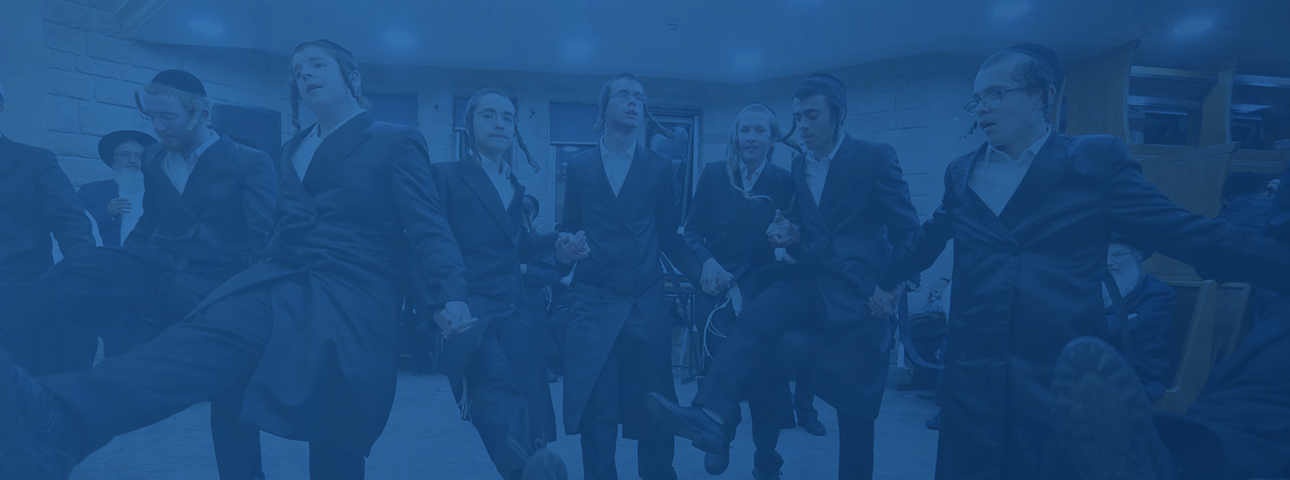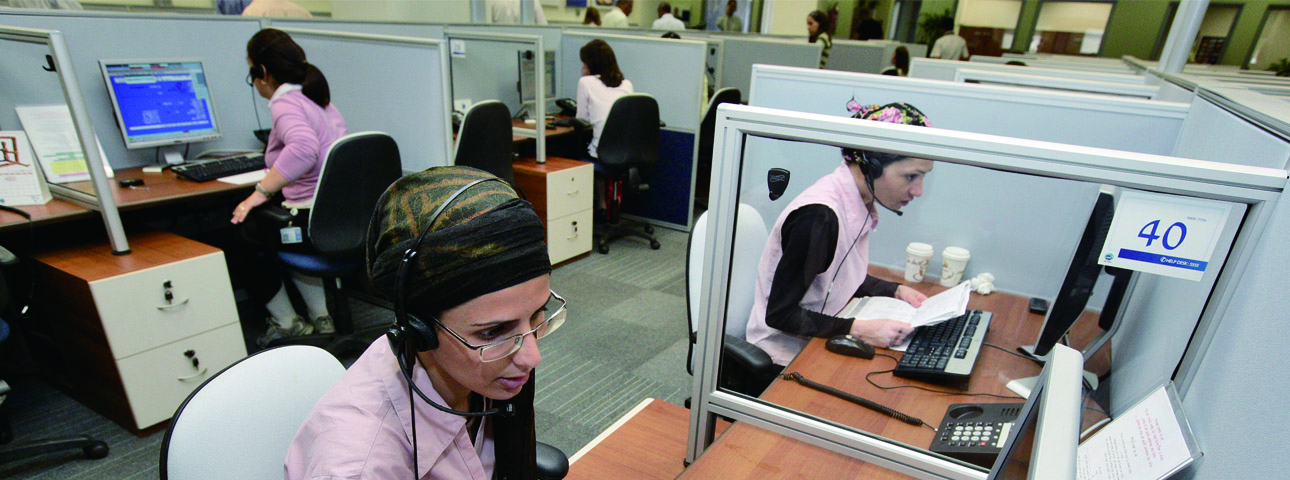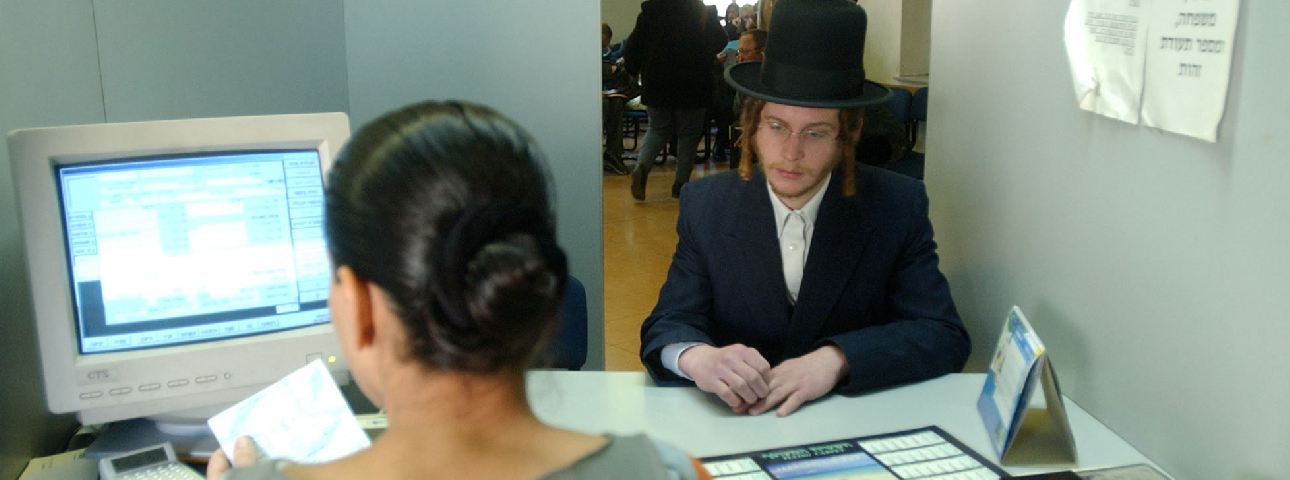Statistical Report on Ultra-Orthodox Society in Israel

The report displays significant changes that have occurred in ultra-Orthodox society over recent years, and indicates growing integration of the ultra-Orthodox into mainstream Israeli society, alongside sustained cultural isolationism. The picture that emerges from the report is one of continued increase in the numbers of ultra-Orthodox students in the higher education system, a rise in the number of those taking high-school matriculation exams, and positive trends in employment (though these have slowed over the last year). In addition, the report reveals the continued existence of gaps in income and in tax returns between ultra-Orthodox Israelis and the general population.
The report shows significant developments within the ultra-Orthodox society - this trend of integration must be encouraged, while allowing the ultra-Orthodox to maintain their beliefs and culture alongside other sectors of Israeli society.Dr. Gilad Malach

Population - This year, the number of ultra-Orthodox Israelis rose above one million for the first time, and they now consist 12% of the population. By 2030, the ultra-Orthodox sector is expected to reach 16% of the total population, and by 2065, will make up one third of Israel’s overall population and 40% of its Jewish population. The ultra-Orthodox population is also relatively young: 58% are aged 0–19, compared with 30% of the rest of the Jewish population. Also, in recent years, there has been a decline in the fertility rate among ultra-Orthodox women, from 7.5 offspring per ultra-Orthodox woman in 2003 to 6.9 today (compared with 2.4 for other Jewish women).
Family status - The marriage rate in the ultra-Orthodox population (aged 20 and above) stands at 82%, compared with 63% for the rest of the Jewish population. However, there has been a rise in age at time of marriage in recent years: while in 2005, 61% of ultra-Orthodox young adults aged 20–24 were married, this figure has now dropped to 44%. A significant shift is also evident across a broader age group. In 2005, 76% of ultra-Orthodox Israelis aged 20-29 were married, compared with just 67.5% in 2016. Accordingly, the marriage rate for ultra-Orthodox women aged 20–29 was 80% in 2005, but by 2016 this had dropped to 67%. A slight decline was also seen in the marriage rates for ultra-Orthodox men over the same period, from 71% to 68%.
Education - There are currently approximately 300,000 students in the ultra-Orthodox education system, representing 18% of the student population in Israel. However, the annual growth rate of the ultra-Orthodox system slowed from 4.2% in 2013 to 3.2% in 2016. By contrast, the annual growth rate of the Hebrew-language state school system rose over the same period from 0.5% to 2.3%. There are two possible explanations for this phenomenon: the falling birth rate in the ultra-Orthodox sector; and the decline in the attractiveness of ultra-Orthodox schools for families who are not explicitly ultra-Orthodox in observance.
The proportion of high-school students in the ultra-Orthodox education system taking matriculation exams has risen from 23% in 2005 to 33% in 2015. This increase can largely be attributed to the fact that the share of ultra-Orthodox girls taking matriculation exams rose during this decade from 31% to 51%, while there was actually a decline among ultra-Orthodox boys from 16% in 2009 to 13% in 2015. It is also worth noting that while the number of full-time ultra-Orthodox yeshiva (seminary) students grew by 4% per year between 1999 and 2012, their number then declined by 16% between 2012 and 2014, a period when there were no ultra-Orthodox parties in the coalition. This decline be partially explained by both subsidy cuts to yeshivas (religious seminaries) as well as lowering the exemption age from military service. Accordingly, in 2016, following the return to the coalition of the ultra-Orthodox parties, the number of full-time yeshiva students grew once more by 4%.
Higher education - The number of ultra-Orthodox students in the higher education system has grown tenfold over the last decade, from 1,000 to 10,800. There are now also approximately 1,500 ultra-Orthodox students in advanced degree programs. Of the ultra-Orthodox students in higher education, 69% are women, and only 31% are men. The breakdown of (bachelor’s degree) subjects taken by ultra-Orthodox students differs greatly from that among the general population: 34% study education, compared with 18% of the general population; 11% study paramedical subjects, compared with 6% of the general population; and only 8% study engineering, compared with 18% of the general population.
Income and expenses - The average monthly income of ultra-Orthodox households is NIS 12,616, approximately 35% lower than the average income of other Jewish households. In a comparison of per capita income, the comparative difference jumps to 171%, with a monthly average of NIS 2,168 in the ultra-Orthodox population and NIS 5,876 for other Jews. The main reason for this is the relativly large size of ultra-Orthodox households. Income from work represents just 65% of ultra-Orthodox household income (24% from pensions and stipends, and only 10% from capital returns), compared with 78% among other Jewish households. Accordingly, benefit payments make up 24% of the income of ultra-Orthodox families, while only 1% of their income comes from capital, pensions, and savings plans, compared with 10% for other Jewish families. Due in part to their relatively low income, the ultra-Orthodox pay an average of just NIS 1,261 per month in taxes, around one-third of the tax payments of other Jewish families.
Despite the relatively large size of ultra-Orthodox families, their monthly expenditures on various products and services are 15% lower than those of other Jewish families, coming to an average of NIS 13,676. Breaking down these expenses by type reveals a great degree of similarity between ultra-Orthodox and other Jewish households regarding spending on food, housing, health, and education. There are, however, differences in expenditures on transport and communications, which make up just 12% of the expenses of ultra-Orthodox households, compared with 21% for other Jewish families. This can be explained in part, because ultra-Orthodox Israelis are more reliant on public transport rather than private cars, and use the Internet and cable television much less.
Poverty - The poverty rate among ultra-Orthodox Israelis fell to 45% in 2016, its lowest level in more than a decade. This is a result of the trend of increased ultra-Orthodox integration into the workforce, along with increased government support.
Housing - Over the last decade (2006–2016), there has been a decline in home ownership in the ultra-Orthodox sector (from 79% in 2006 to 75% in 2016), while ownership rates in the rest of the Jewish population have remained steady. This is an indication both of economic difficulty and of social change processes that have made renting a home more acceptable for young couples.
Transportation - Only 42% of ultra-Orthodox Israelis hold a driver’s license (compared with 81% of other Jewish Israelis), though there has been a significant rise in the number of ultra-Orthodox women with a driver’s license, from 21% in 2008 to 29% in 2016. Accordingly, only 41% of ultra-Orthodox households own a car (compared with 79% of other Jewish households), though this represents a significant rise since 2003, when the figure was 31%.
Among ultra-Orthodox employees, only 20% travel to work by car (compared with 51% in the general population). A quarter (25%) of ultra-Orthodox men travel to work by public transport, and 14% walk. Only 16% of ultra-Orthodox women travel to work by car, 36% by public transport, 19% on foot, and 7% by bus, provided by their employers. One interesting trend is that ultra-Orthodox Israelis are traveling further to work: while in 2013, 45% traveled no more than 15 minutes to their workplace, in 2016, this dropped to 40%. Among women, the proportion of those who work close to home has fallen from 48% to 38% over the last three years.

Employment - Since 2002, ultra-Orthodox employment rates have increased from 35% of men and 50% of women to 52% and 73%, respectively. However, the steady rise seen in recent years stagnated in 2015 and 2016. It would seem likely that the policies of the current government, which has reduced incentives to enter the workforce and increased support for full-time yeshiva students, have played a role in this slowdown.
The average salary of ultra-Orthodox employees is significantly lower than that of other Jews, at NIS 6,701 versus NIS 10,776. The difference between salaries of ultra-Orthodox men and other Jewish men is 39%, compared with 32% for women. The lower wages for men are due mainly to lower hourly wages (73% of the average), while among women, the gap is largely due to the fact that 78% of ultra-Orthodox women work in part-time jobs. A significant trend noted in the report relates to the fields of employment of ultra-Orthodox women: while in 2001, 64% of ultra-Orthodox women were employed in education, this figure has now declined to 42% (compared with 17% among other Jewish women).
Only 6% of employed ultra-Orthodox Israelis, hold managerial positions, compared with 15% among the general Jewish population. Ultra-orthodox employees also attribute less importance to advancement at work than their counterparts—41% versus 51%. However, more than half of ultra-Orthodox young adults (aged 20–34) view promotion prospects at their workplace as important. For ultra-Orthodox Israelis, work is seen mainly as an existential need: 57% define their salary as the most important factor in wanting to change jobs, compared with 37% in the rest of the Jewish population. At the same time, while 77% of older ultra-Orthodox workers view income as the main reason to move to another job, only 48% of the younger group feels this way.
Job satisfaction - Ultra-Orthodox Israelis are happier with their home-work balance: 67% say they are satisfied, compared with 57% of their counterparts in the general Jewish population. Of employed ultra-Orthodox Israelis, 92% feel that their work has value, 96% feel that their managers treat them with respect, and 83% have not been given tasks that clash with their values. Surprisingly, 96% of ultra-Orthodox employees report that they have never encountered discrimination in the workplace. However, ultra-Orthodox workers describe their workplace as more pressured than do the rest of the Jewish population: only 42% are able to take frequent breaks, compared with 61% in the general Jewish population, and only a minority are members of a union (17%, compared with 33% in the general Jewish population).

Military service - In 2016, despite the repeal of the “Equal Burden” Law, 34% of graduates of the ultra-Orthodox education system enlisted in the IDF or joined a civilian national service framework (some 3,500 ultra-Orthodox men). Having said that, the IDF has not met its enlistment targets over the last year, particularly for civilian service, which registered only 667 volunteers rather than the target of 2,000. Of the ultra-Orthodox men who enlisted, 81% preferred military service, and only 19% chose civilian service.
Technology - In recent years, there has been a significant increase in Internet use among ultra-Orthodox Israelis, from 28% in 2009 to 43% in 2016. Ultra-Orthodox women use the Internet more than men—47% versus 39%.
Leisure - Just under half (49%) of ultra-Orthodox Israelis vacation in Israel, compared with 61% of the rest of the Jewish population. The gaps are wider regarding foreign vacations: 16% of ultra-Orthodox Israelis travel abroad, compared with 47% of the rest of the Jewish population. However, this figure has risen in recent years, from 12% in 2014 to 16% in 2016, indicating the development of a leisure culture and the growth of an ultra-Orthodox middle class.
The 2017 Statistical Report on Ultra-Orthodox Society in Israel is published by the Israel Democracy Institute and Jerusalem Institute for Policy Research.
The report was prepared by a joint research team representing the two institutes that included Dr. Lee Cahaner, Dr. Maya Choshen, Dr. Gilad Malach, and Dafna Shemer.
This publication was made possible by a generous donation from The Russell Berrie Foundation.
